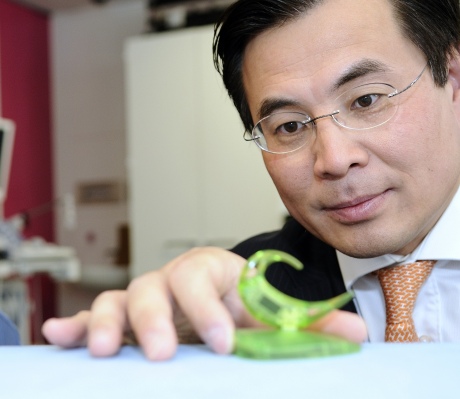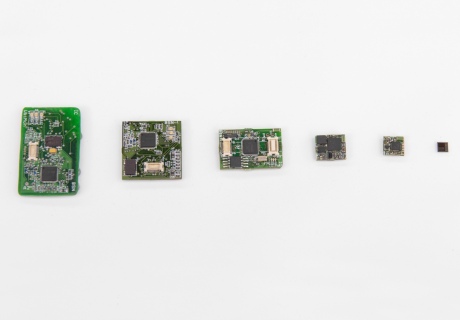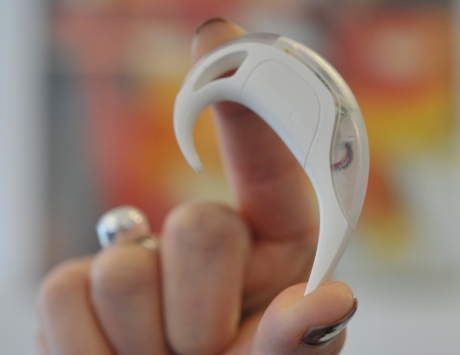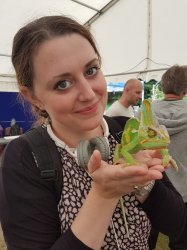

One of Imperial's leading robotics experts will talk about the future of wearable tech and its implications for health in talk this Saturday.
Professor Guang-Zhong Yang, of Imperial College London’s Department of Computing, is Director and co-founder of the Hamlyn Centre for Robotic Surgery at Imperial. The Centre aims to improve health worldwide by using Imperial’s research strengths and expertise in safe, effective and accessible technologies.
It’s no longer enough to have just new gadgets; they must also be smart, compact, convenient and attractive. This is where the design aspect comes in.
– Professor Guang-Zhong Yang
Director, Hamlyn Centre
This Saturday, Professor Yang and Dr Benny Lo of the Hamlyn Centre and the Department of Surgery & Cancer will deliver talks and demonstrations on the future of design and engineering for health at the Design Museum’s ‘The Future of Health’ event.
In collaboration with Imperial’s Centre for Continuing Professional Development, the talk will bring designers, scientists, and artists together to explore how wearable technology can help improve our lives.
Caroline Brogan spoke with Professor Yang to discuss his work and vision for the future of attractive wearable technology.
What can we expect this Saturday at the Design Museum?
Smart technology is evolving at an incredible pace, and beginning to transform the way we diagnose, treat and rehabilitate patients. My talk and Dr Lo's demonstration will give insights into how wearable devices are changing our relationship with our bodies, as well as the ever evolving role of wearable technology in healthcare. The interactive demos will show off our exciting technology, followed by more talks from other world-renowned experts in the field.

Professor Yang with the ear-worn Activity Recognition (e-AR) sensor.Credit: Jo Mieszkowski; Hamlyn Centre
Our part will focus on the invention of the ear-worn Activity Recognition (e-AR) sensor, a small piece of technology that clips behind the ear to measure and give feedback on walking and balance after knee surgery.
Can you describe the work you do here at Imperial?
I use robotics, sensing and imaging in medical diagnostics, surgery and rehabilitation. I’ve been involved in inventing robots that help surgeons in theatre and intricate micro-surgical robots for complex procedures during operations.
The Hamlyn Centre embodies the combined principals of engineering and design, and is one reason Imperial plays a leading role in wearable tech today. The upcoming event at the Design Museum is tribute to this exciting combination.
How has the focus of your work changed in recent years?
Machinery, engineering and robotics have already transformed many areas of our lives. However, only in the past decade have we begun to consider comfort and appearance as an integral part of developing these technologies. Now, the design aspect of innovation is at the forefront of my work alongside improving health, both of which contribute to improving human lives.
At which point do the worlds of engineering and design collide?
Bringing together the designer, the engineer and a design critic, we will share the design and engineering story behind e-AR, before going on to explore how e-AR and others like it are set to transform the world we live in.
– Professor Guang-Zhong Yang
Director, Hamlyn Centre
The focus of any engineering venture has always been to create technology to improve our lives. However at some point engineers realised the potential of their work and strived not just to make wearable technology, but to also to create something that’s a pleasure to use and wear.
It’s no longer enough to have just new gadgets; they must also be smart, compact, convenient and attractive. This is where the design aspect comes in.
Engineers have evolved alongside technology and this way of thinking, and those at the forefront are those who have learned to work smarter and smaller.
Take your average sized wearable microsensor chip - these are now a fraction of the size they were ten years ago.

Visual representation of how the average sized wearable sensory microchip has evolved over around a decade, from large to small. Credit: Thomas Angus; Hamlyn Centre museum.
Which piece of technology are you most proud of in terms of human impact and good design?
e-AR. This is a wearable device that clips behind the ear like a hearing aid to measure the way a person walks or runs, otherwise known as gait. e-AR provides instant feedback and instructions via smartphone app or smart watch, and is used in surgical rehabilitation and athletic training.
Patients rehabilitating from operations that affect walking, such as in knee or hip replacements, can use e-AR for rehabilitation. It measures posture, stride length, step frequency, acceleration, and shock waves travelling through the body while the patient walks around the house or street.

e-AR is the size of the average hearing aid. Credit: Jo Mieszkowski; Hamlyn Centre
As well as being used for rehabilitation it can also be used by athletes in training, by transmitting visual data to their coaches at the side lines for instant feedback and direct real-time instruction.
How is this improvement on traditional methods?
Traditionally we have studied gait by measuring people on an instrumented treadmill with a safety harness in a dedicated clinic. This meant we could provide feedback on gait, but treadmill walking is very different to all the uneven surfaces, steps and slopes you’d expect to encounter when out and about. The e-AR is in stark contrast to that.
e-AR is the embodiment of what we at the Hamlyn Centre work towards every day. Bringing together the designer, the engineer and a design critic, we will share the design and engineering story behind e-AR, before going on to explore how e-AR and others like it are set to transform the world we live in.
Professor Yang and Dr Lo’s talks on ‘The Future of Health’ will take place on Saturday 23 September. The event is the result of collaboration between the Design Museum and Imperial’s Centre for Continuing Professional Development.
The Hamlyn Centre is funded by grants from Wolfson Foundation, National Institute of Health Research (NIHR), the Engineering and Physical Sciences Research Council (EPSRC) and the Royal Society. The Centre is part of the Institute of Global Health Innovation (IGHI) at Imperial.
Supporters


Article text (excluding photos or graphics) available under an Attribution-NonCommercial-ShareAlike Creative Commons license.
Photos and graphics subject to third party copyright used with permission or © Imperial College London.
Reporter

Caroline Brogan
Communications Division

Contact details
Tel: +44 (0)20 7594 3415
Email: caroline.brogan@imperial.ac.uk
Show all stories by this author



